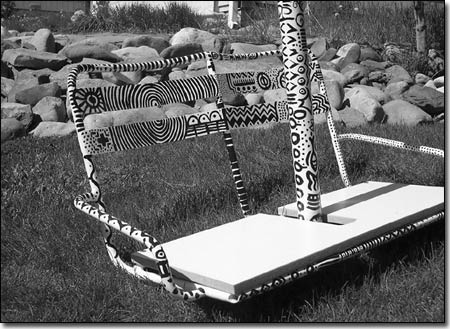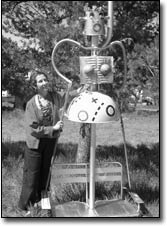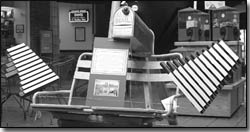|
A Lift for Chair-ity fund-raiser benefits
ASA
by Amy Maestas
 |
| Local artist-couple Shan and Regina
Wells painted this chairlift, which will be auctioned
off as a fund-raiser for the Adaptive Sports Association.
Six former double chairs from DMR’s old Lift
1 will be transformed into practical works of art
and auctioned to benefit the organization./Courtesy
photo. |
Durango’s Adaptive Sports Association, which has
been around for more than 20 years, now has its own patron
saint. Built from various pieces of scrap, the saint,
who towers more than 7 feet and has lanky arms like a
monkey and curly yellow hair, welcomes company. After
all, she is part of Durango Mountain Resort’s history,
having worked hard shuttling skiers up Lift 1 for years.
The patron saint, created by local artist Krista Harris,
is part of a current fund-raiser for the nonprofit organization.
But the saint won’t be sitting in the ASA offices,
watching over its staff and students. Instead, she’ll
end up wherever her winning bidder sets her.
“A Lift for Chair-ity” is ASA’s new
fund-raising event. It includes six double chairs from
DMR’s original Lift 1. In an effort to provide local
artists a creative outlet while also raising money for
the organization, ASA is auctioning off the chairs, which
can be used as everything from porch swings to patio benches.
 |
Krista Harris poses next to her
chair, “Patron Saint.”/Courtesy
photo. |
Each local artist given a chair has made his or her own
imaginative mark. Harris’ patron saint is a colorful
collection of scrap she found in her own back yard.
“We have a big junk pile I’m always complaining
about, but every time I need something, I go to it,”
says Harris.
From the pile, she fetched the saint’s yellow skirt
– what once was the bottom of a Weber grill. The
skirt, held in place with two welded-on horseshoes, sports
an ASA theme with the organization’s logos. Her
arms are metal conduit pipe. She has a red tin heart on
her vented chest. Her bucket head is fleshed out with
drawer-pull eyes, a bicycle cog for her mouth and drain
baskets for ears, which Harris says came from a 1950 Spartan
aluminum trailer she and her husband restored last year.
Harris makes her living mostly as a graphic artist. But
her heart is in oil and mixed media painting. With that
experience, she says it “wasn’t much of a
stretch to do something in 3-D.” From the beginning,
she wanted to do some sort of collage that would truly
incorporate the spirit of the ASA, for which she has been
a volunteer for several years.
“It’s very unique in what they offer,”
she says. “The organization gives back to its students
a sense of independence and security. I think it’s
a new way for the public to see people with disabilities.”
The style of art on the chairs varies widely. Each is
inimitable in its own way, in spite of the same underlying
structure of a two-person seat. Carl Stransky’s
chair showcases his welding talent. His chair has neatly
welded feet for a solid foundation. Above the seat rises
a green-and-white striped umbrella – perfect shade
for its sitters.
Artistic couple Shan and Regina Wells used a sort of
funky black-and-white pop art design. Equally as funky
is the brightly flower-themed chair decorated by Debra
Greenblatt and Bonnie Ward. Flowers adorn every bit of
the chair, including the sunflowers that wend their way
up the chair post and the ivy that creeps along the back.
There is also a chair painted by several students from
the Kindred Spirit art class. The students, many of whom
participate in ASA activities because of disabilities,
bandied about their ideas for a colorful theme. Margaret
Pacheco, the class instructor, meets each week with the
class. For this project, she explains, she lit the students’
creative fire by making it personal.
“I asked them from the beginning, ‘What would
you want on your chair?’”
The students initially drew their designs on paper. Collectively,
they determined a theme of vivid and dazzling colors –
based on student Richard Siegele’s chosen color
scheme of purple and green.
Pacheco says eventually, the class incorporated every
student’s design, even though only a handful actually
did the painting.
Aside from guiding the Kindred Spirit chair, Pacheco
contributed to the fund raising with her own chair design.
 |
| Margaret Pacheco's piece “Earth
Angel” sits in the Main Mall on Tuesday./Photo
by Todd Newcomer. |
A lifelong artist and Ignacio native, Pacheco’s
involvement in community services ultimately led to the
idea for “Earth Angel” – the title of
her chair. Pacheco is a volunteer at Mercy Hospital and
one day noticed an instrument that therapists use as a
healing tool for patients. Intrigued, Pacheco –
who is also a Healing Touch Practitioner and music teacher
– set out to find more about this xylophone look
alike. Not only did she want to understand its roots,
she also wanted to somehow use one in an art project,
she says.
“I asked around, but no one quite knew enough about
the instruments,” she says. “But I just had
to find out about them, because I wanted my project to
be about yin and yang.”
In a fortuitous chat with a member of the arts community,
Pacheco found out that a local musician invented and builds
the instruments, called Freenotes. This percussion instrument,
much like the gamelan instruments of Java and Bali, harmonize
no matter how someone plays them.
With a bit more research, Pacheco quickly garnered two
“Wings” of Freenotes and welded them to the
sides of the chair. Anyone who sits in the chair can play
the Wings and create harmonious music without a lesson
or musical adeptness.
Pacheco also painted the chair in a cool, aqua tone that
creates a soothing air. On the back of the chair she used
iridescent paint to write a verse that is only visible
upon close observance. It states: “The river sings
a song and we can all sing along.”
“I wanted the chair to be reflective of the river
and natural world,” says Pacheco.
Along with Pacheco’s chair, all other chairs in
the project are reflective of the local community.
Jaime Papi, ASA administrative assistant, says the group
is pleased with the chairs.
“They are all so creative. They are one-of-a-kind,
functional art.”
Though this is the first project of this type ASA has
undertaken for a fund-raiser, Papi is hopeful that its
success will allow more such benefits in the future.
“The community has always been supportive of Adaptive
Sports,” she says. “This is another way for
us to get our name out there for people to know what we
do.”
|

